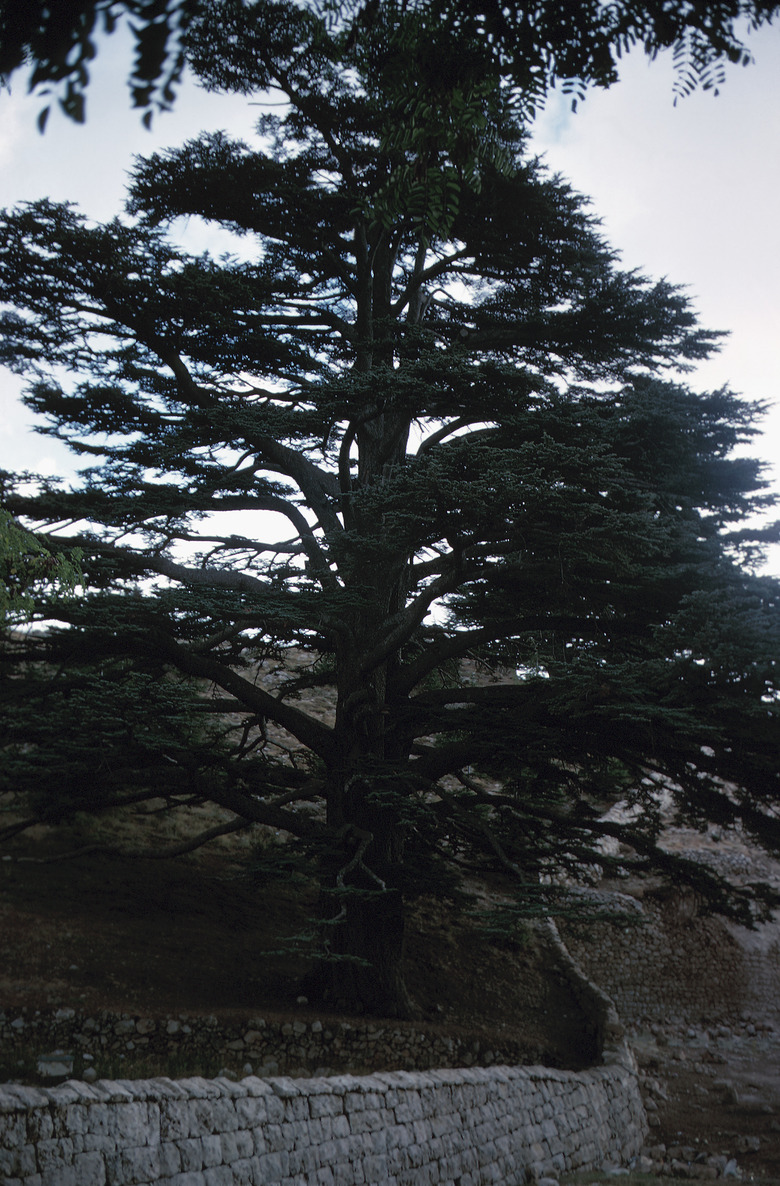Cedar Vs. White Cedar
The term cedar is used as a common name to identify a number of evergreen tree species. There are many types of evergreen trees with cedar as their common name, such as the eastern white cedar, Atlantic white cedar and western red cedar. There is, however, only one genus of true cedar trees (Cedrus spp.). True cedars and white cedars have a number of notable similarities and differences.
True Cedars
True Cedars
True cedars are a genus of coniferous, evergreen trees that originally come from the western Himalayas and Mediterranean regions. True cedars are in the pine family Pinaceae. The name cedar is derived from a Greek word meaning "resinous tree." All cedar trees have deliciously scented, resinous wood. The wood and essential oil of true cedars is known for its insect-repelling properties. Cedar wood is also known for its ability to absorb moisture and for deodorizing.
True cedar trees have broad, level branches and needle-like leaves. Their leaves grow in spiral-shaped clusters. The cones of true cedars are barrel-shaped, can grow up to five inches long and disintegrate at maturity to release their delicate, winged seeds. The seeds contain bad-tasting resin that is thought to deter squirrels from eating the seeds.
There are four species of tree in the true cedar genus (and over 100 cultivars). These are Cedrus deodara (deodar or Himalayan cedar), Cedrus atlantica (Atlas cedar), Cedrus brevifolia (Cyprus cedar) and Cedrus libani (cedar of Lebanon). True cedars are chosen as decorative plants because of their lovely, soft foliage, which can range in color with hues of blue, green, white and cream. Cedars tend to be resilient plants, resisting disease and pests and responding well to pruning.
False Cedars
False Cedars
There are a number of evergreen trees that are named "cedar" but are not in the genus Cedrus. False cedars are similar to true cedars in that they are all types of evergreen conifers. True cedars and false cedars all tend to have rather spicy, aromatic wood that is useful for industrial and household purposes because of its resistance to rot and insect damage. Some types of false cedars include the western red cedar (Thuja plicata), eastern red cedar (Juniperus virginiana), Atlantic white cedar (Chamaecyparis thyoides) and incense cedar) (Calocedrus decurrens).
Black Cedar vs. White Cedar
Black Cedar vs. White Cedar
Two common types of false cedar are black cedar and white cedar. Neither of these types of evergreens are from the true cedar genus, Cedrus. White cedar (Thuja occidentalis) is a member of the Cypress family of plants (Cupressaceae) and also is known as the swamp cedar or arborvitae. The term arborvitae, meaning "tree of life," was given to white cedars in reference to the effectiveness of their foliage in treating scurvy.
White cedars are smallish trees that can reach 40 feet tall. They have scale-like leaves and tiny, cone-like monoecious flowers. Their small, cinnamon-colored cones reach up to 1/2 inch in length. White cedars are common throughout boreal areas of North America and prefer cool, moist, nutrient-rich soils. They are commonly associated with balsam fir and tamarack.
The wood of white cedars is similar to true cedars in that it is insect- and rot-resistant. Historically, white cedar wood has been used for fence posts, cabin logs, saunas, poles, lumber, shingles, barrels and any other situation where wood might be exposed to water for extended periods of time. Cedar leaf oil is made from the boughs of white cedar trees.
White cedars are a crucial part of the ecosystems in which they live, providing shelter for animals such snowshoe hares, porcupine, red squirrels and white-tailed deer. White cedars are an important source of browse material for white-tailed deer during winter months.
Black cedar (Thuja occidentalis 'Nigra') is a common cultivar of white cedar. Black cedar is also called American arborvitae or eastern arborvitae. These trees are frequently planted as hedging, due to their year-round dark green foliage and dense, columnar growth habit.
Atlantic White Cedar
Atlantic White Cedar
Another type of cedar is the Atlantic white cedar, Chamaecyparis thyoides. Atlantic white cedar is also commonly called southern white cedar and swamp cedar. There are subpopulations of Atlantic white cedar in the southeastern United States, as well as the northern and mid-Atlantic regions of the United States. Atlantic white cedar can grow to 75 feet tall and prefers moist, sandy soil.
Atlantic white cedar swamps are wetlands that are created and inhabited by Atlantic white cedars, occurring in the northeast region of the United States. The water in these swamps is acidic due to the presence of the Atlantic white cedar trees, and therefore is highly preservative in nature. Ancient logs mined from Atlantic white cedar swamps have been found to be usable for lumber after spending hundreds of years underwater.
Wood from Atlantic white cedar trees has long been a valuable resource for building materials, such as lumber, flooring, shingles and logs for cabins. During the Revolutionary War, charcoal made from Atlantic white cedar wood was used in the production of gunpowder. Now, Atlantic white cedar swamps are vulnerable ecosystems, due to their sensitivity to changes in environmental conditions (especially changes caused by humans). Cedar swamps should be conserved and appreciated, as they are an amazing place to go for a boardwalk stroll!
References
- American Conifer Society: 10 Types of Cedars That Everyone Should Know
- American Conifer Society: Cedrus Genus
- BorealForest.org: Thuja Occidentalis – Eastern White Cedar
- Lady Bird Johnson Wildflower Center: Chamaecyparis Thyoides (Atlantic White Cedar)
- California Native Plant Society: Incense Cedar, Calocedrus Decurrens
- Connon Nursuries: Black Cedar (Thuja Occidentalis 'Nigra')
- Maine Department of Agriculture, Conservation and Forestry: Atlantic White Cedar Swamp
Cite This Article
MLA
Reinbold, Joan. "Cedar Vs. White Cedar" sciencing.com, https://www.sciencing.com/cedar-vs-white-cedar-8766975/. 30 September 2021.
APA
Reinbold, Joan. (2021, September 30). Cedar Vs. White Cedar. sciencing.com. Retrieved from https://www.sciencing.com/cedar-vs-white-cedar-8766975/
Chicago
Reinbold, Joan. Cedar Vs. White Cedar last modified March 24, 2022. https://www.sciencing.com/cedar-vs-white-cedar-8766975/
